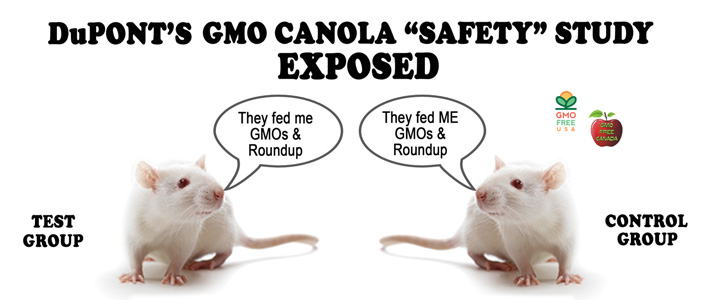
Control animals fed GMOs and pesticides makes industry GM canola safety study worthless
Who would have expected that toxicology would become a rich reservoir of farce and irony? Yet that is exactly what has happened in the area of GMO toxicity testing, thanks to double standards that mean studies finding harm are judged very differently to those finding safety.
The latest episode in the farce is a GMO industry safety study designed to test the effects in rats fed a GMO canola compared with rats fed non-GM canola. Unfortunately, the test animals were fed GMOs and pesticides and control animals were also fed – er – GMOs and pesticides. Unsurprisingly, the study found no effect from feeding the GM food under test and concluded that it was safe. In spite of its poor design, the study could be used to gain regulatory approval for the GM Roundup-tolerant canola under test.
The study (Delaney and colleagues, 2014) was published in April this year by employees of the biotech and agrochemical giant DuPont in the journal Food and Chemical Toxicology (FCT). Readers will recall that in November 2013 the editor of this same journal, A. Wallace Hayes, forcibly retracted the long-term rat feeding study by the team of Prof Gilles-Eric Séralini. Séralini's study found toxic effects in rats fed doses of NK603 GM maize and Roundup deemed safe by regulators. Hayes claimed he retracted the paper on the grounds of the "inconclusive" nature of the tumour and mortality findings in treated groups of rats. He blamed the alleged inconclusiveness on the relatively low number of rats used and the strain of rat, the Sprague-Dawley, which he claimed was unusually prone to tumours.
Hayes's rationale for retracting the paper – inconclusiveness – was widely derided by scientists. Prof Jack Heinemann of the University of Canterbury, New Zealand pointed out that if this standard were applied consistently, this would result in a huge number of important studies being retracted, including two pioneering papers by James Watson and Francis Crick describing the structure of DNA and how it might replicate, which at the time of publication were inconclusive.
Now Séralini's team has hit back at the FCT editor's accusations in an analysis of the DuPont study. The analysis, published in FCT as a letter to the editor, exposes as worthless the DuPont authors' claims of safety for the GM canola variety tested.
Séralini's team analysed the laboratory rodent diet used in the DuPont experiment, which was obtained from a well-known company called Purina. They obtained the same type of feed from Purina and found that it was contaminated with 18% of Roundup-tolerant maize NK603 and 14.9% of GM Bt maize MON810. They also found that the feed contained residues of glyphosate and AMPA (the main metabolite of glyphosate). So although the control rats weren't eating the GM canola under test, they were eating other GMOs with the same glyphosate-tolerant trait, as well as residues of the pesticide that the GMOs are grown with. In plain English, the study did not compare rats fed a GM diet with rats fed a non-GM diet, but rats fed one type of GMO plus pesticides with rats fed similar GMOs plus pesticides.
Séralini and colleagues state, "the uncontrolled presence of pesticide residues and other GMOs make the study inconclusive". They add that according to the criteria of the FCT editor Hayes, the study should be retracted.
Séralini's team, in contrast, did control for GMOs and pesticides in the diets used for their chronic toxicity study. So their study accurately tested for the effects of GM NK603 maize and Roundup herbicide – and the effects of organ damage and hormonal disruption found in the treated rats were real.
Spurious control groups
The DuPont researchers made their study even more inconclusive by restricting it to a 3-month timespan too short to show long-term health effects. They also added spurious control groups of animals fed a variety of irrelevant "reference" diets. This practice, common in the GMO industry's studies on its own products, has the effect of drowning out any statistical differences in the GM-fed group in the resulting "data noise". Many industry studies with a similar poor design have been published in FCT and were not retracted.
FCT editor Hayes based his verdict of the "inconclusive" nature of the tumour and mortality findings in the Séralini paper on the relatively small number of rats used and the supposedly tumour-prone nature of the Sprague-Dawley strain. Yet the DuPont authors concluded on safety over a shorter period of time, measuring a smaller number of health effects, and using a comparably small number of rats (12 per sex per group compared with Séralini's 10) of the same Sprague-Dawley strain.
There is further irony in the fact that we are not allowed to suspect that DuPont's reassuring findings on its own GMO might be a false negative, where a toxic effect exists but is missed because of poor experimental design. But conversely we are expected to believe that Séralini's findings, dramatic as they are, are all false positives and an artefact of the small number of rats used and the rat strain chosen – two factors which miraculously become acceptable in the DuPont study and many other industry studies.
To round off this GMO farce, the DuPont authors declare in their paper that "there are no conflicts of interest" – despite the fact that they are employees of the company that stands to profit from the market authorisation of the GMO in question. And Bryan Delaney, the first author of the DuPont study, is also managing editor of FCT. That interest too goes undisclosed.
If these shenanigans weren't putting public health at risk, we'd be rolling in the aisles.
(by Claire Robinson)
Image courtesy of GMO Free USA and GMO Free Canada









